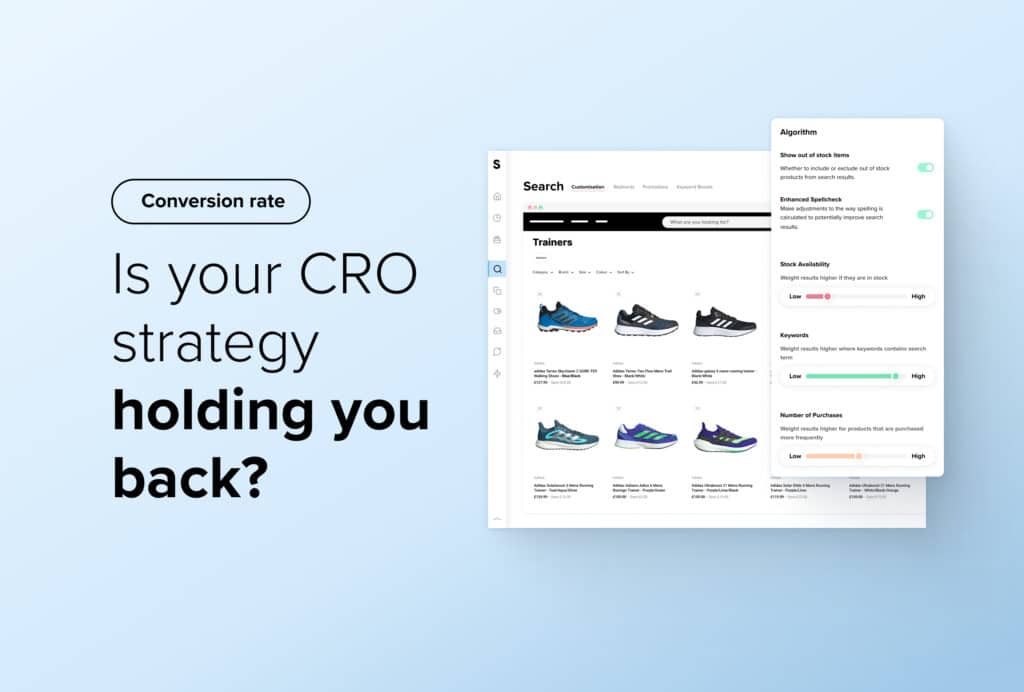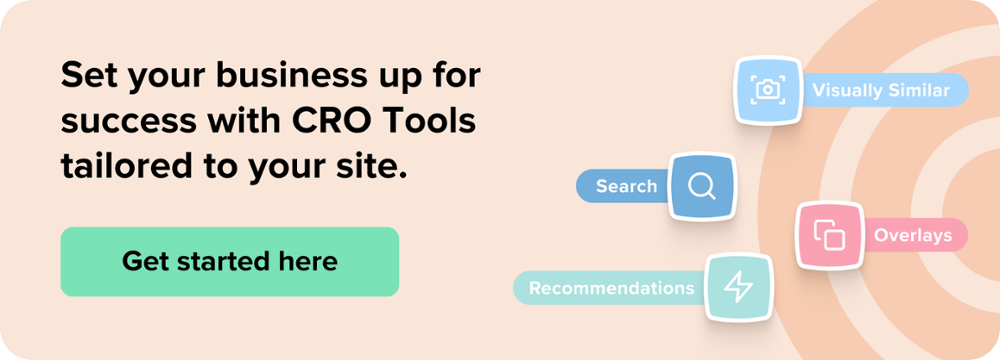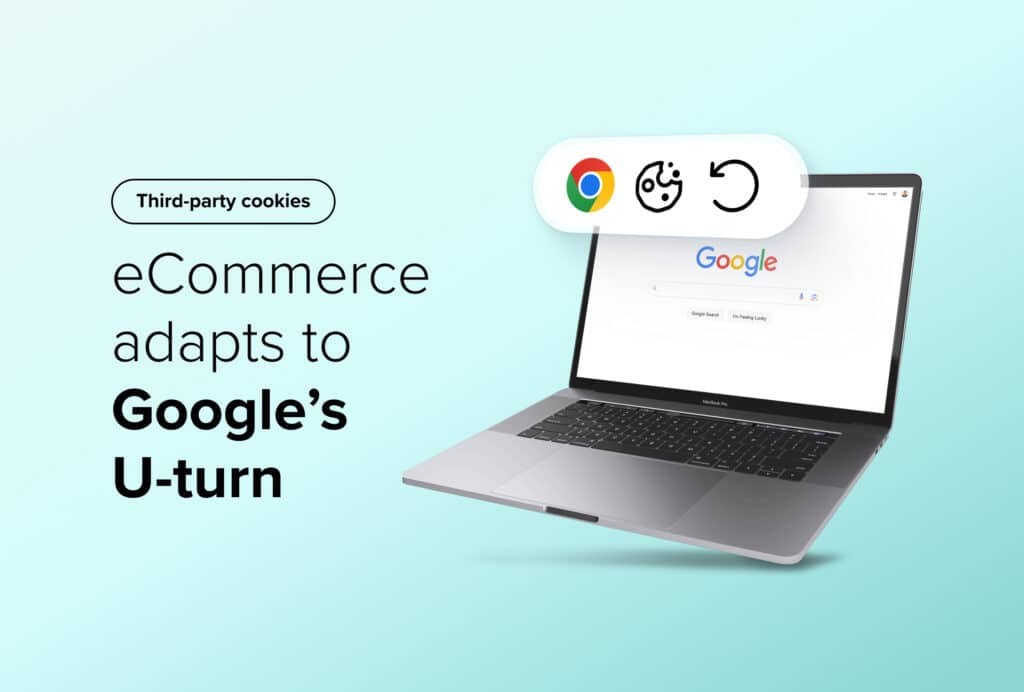Why Your eCommerce CRO Strategy Isn’t Working (And How To Improve It)
By Courtney O'Riordan • Last updated: Thursday Jul 18th, 2024

Creating a strong and successful conversion rate optimisation (CRO) strategy isn’t easy.
But getting it right is vital for the growth and profitability of eCommerce businesses.
To help you on your way to perfecting your CRO strategy, here’s a well-rounded look at where you might be falling short and what you can do to improve.
Suggested reading: Watch our webinar, ‘From Google Shopping to On-Site Conversions: A Deep Dive with Bidnamic’, to learn more about how to boost eCommerce conversions.

What is an eCommerce CRO strategy?
Conversion rate optimisation is the process of increasing the percentage of website visitors who complete a desired action.
This desired action can be whatever you choose to define it as within the context of your eCommerce website. Common examples for online retailers include:
- Completed purchases
- Newsletter sign-ups
- Account creation
- Increased website traffic
- Content interaction
When conversion rate is discussed in the context of eCommerce, it’s most commonly defining a conversion as a completed purchase. Using this definition, the average conversion rate across eCommerce sectors is approximately 3.42%.1
Pro tip: Starting from scratch? Take a look at our article ‘The Ultimate eCommerce CRO Checklist’.
Why is an eCommerce CRO strategy important to your business?
Complacency with your conversion rate is not possible within the current eCommerce landscape.
Let’s discuss why a CRO strategy is important for your online store’s success and why you should invest in it.
1. Protects finances during economic difficulty
Unfortunately, the current economic downturn is not set to significantly improve any time soon.2
With this in mind, online businesses should place notable importance on securing future sales and establishing a recession-proof eCommerce business.
Achieving this begins with improving customer retention rates. After all, acquiring a new shopper costs five to seven times more than retaining an existing one.3
The improvement of your CRO strategy will:
- Enhance the customer experience by streamlining the user journey.
- Encourage shopper loyalty as customers receive better onsite experiences.
- Drive conversions over time, increasing ROI on your marketing efforts.
This will improve the efficiency of your marketing spend, saving money on acquisition costs and securing repeat purchases despite an uncertain future. Getting started with CRO is the first step towards securing your business’s future and establishing a growth plan.
2. CRO strategies can be adapted to your business
The eCommerce industry is highly competitive. So much so, that the space can be intimidating for businesses of all sizes, especially startups.
Reassuringly for all retailers, companies of any size can achieve success with CRO strategies.
Understanding the needs of your business and the pain points of your customers will allow you to select the CRO approach that’s right for you.
No matter the size of your goal, you can adjust your strategy accordingly to ensure you see results.
3. Enhances the efficiency of cross-channel marketing
Getting the best results from your omnichannel eCommerce strategies should be a priority, and CRO can support you in achieving this.
It’s likely that your marketing strategies are working to encourage shoppers to head to your site and make a purchase. It’s important to ensure the customer journey is streamlined and your marketing is seamlessly integrated across different channels, otherwise:
- You risk losing potential customers halfway down the sales funnel.
- Your overall marketing strategy will be less effective.
- You may be left with dissatisfied customers and reduced sales.
Your cross-channel marketing efforts will result in more conversions when your site is optimised to convert potential customers into paying consumers. There are a number of ways this can be done, and CRO is at the centre of many of them.
Is your current CRO strategy falling short?
Simply existing as an eCommerce retailer at this time requires a lot of time and effort.
With changing consumer behaviour, new industry trends and ever-evolving tech, it can be difficult to thrive in every area of business. And while the eCommerce industry has been steadily growing over the last 10 years — and particularly over the last three years — it is also becoming more competitive.4
Adding to this, 2023 has been particularly challenging amid the cost of living crisis. Half of UK consumers have cut back on non-essential spending, and many will be less likely to use their credit card to buy items online.5
So, how do you know that you should focus some of your resources on improving your CRO strategy?
- Your site doesn’t prioritise the customer journey: A low conversion rate could mean that your site isn’t meeting the expectations of your customers. Building a hyper-personalised customer experience that guides visitors to their perfect purchases has become a requirement for the modern shopper, for example through an AI-driven customer journey.
- You don’t utilise your site data: 58% of companies say they make decisions based on ‘gut feel’ or ‘experience’, rather than on verifiable data.6 Doing this means you may not be keeping up with trends, gaining insight into product performance or competing with competitors as well as you could be.
- You’re using outdated technology: With expectations set by social media platforms, it’s essential that eCommerce sites replicate these experiences with on-site tech and CRO software.
If you have identified that your site is doing all or some of the above, you don’t need to worry.
This presents a huge opportunity for you to improve your conversion rates by implementing a robust CRO strategy.
How to improve your CRO strategy
Let’s delve into a few approaches any eCommerce business can implement to optimise its CRO strategy.
1. Take advantage of data
Take the guesswork out of improving your CRO strategy by making data-driven decisions.
There’s a wealth of data available to you which allows you to get to know your customers. Many eCommerce sites will use the data provided by Google Analytics to directly assess the performance of their website.
However, it’s important to also compare this data to industry benchmarks using solutions like Salesfire’s free Trends tool. Trends allows you to see conversion rates, AOVs, pageviews, revenue, and much more across the eCommerce industry.
With this data, you can identify where improvements may be needed on your site. Here are some of the steps you can take to boost conversions using data:
1. Kickstart your data analysis by delving into your website analytics to discover pages with high bounce rates. This will give you a great starting point for understanding which landing pages you should be focusing on optimising.
2. Take a look at your best-performing pages to replicate elements of their success elsewhere on your site. This could be as simple as replicating certain visuals and can have a dramatic effect on the success of a page.
3. Keep a close eye on how your conversion rates compare to those of your competitors, as this can vary significantly month-on-month. If yours is much higher or lower, look at competitor sites to see what they are doing differently and to get ideas for improving your site.
Making use of eCommerce data will allow you to make better decisions that can drive an uplift in conversions.
Pro tip: Read our article, ‘The CRO Metrics to Measure for eCommerce Success’, to discover which CRO metrics you should be watching in 2023.
2. Prioritise the customer experience
As a retailer, it’s important to understand that optimising the on-site customer experience is vital if you aim to increase your conversions.
There are a number of ways you can optimise your site to meet the wants and needs of consumers.
We recommend beginning your optimisation process by reviewing your product pages.
These pages have the potential to become high-converting when optimised to drive product attention, building consumer confidence and pushing customers towards the checkout process.
Here are some optimisation tips that will allow you to begin increasing your conversion rate:
- Craft accurate and helpful product descriptions: One of the biggest hurdles eCommerce stores face is the fact that customers cannot touch, hold and inspect physical products before they buy. Eliminate the potential for website abandonment or returns by providing descriptions that provide as much relevant information about a product as possible.
- Display high-quality images: Continue to build consumer confidence with multiple images that accurately represent what your product looks like in real life. You can do this across your social media channels as well as your product pages to improve conversions for the long run.
- Optimise CTA buttons: Eliminate friction in the customer experience by placing clear CTAs above the fold on all product pages. You want to make it as easy as possible for shoppers to locate their desired item and complete their purchase.
Implementing these suggestions on-site creates a positive customer experience that increases customer happiness, retention rates and revenue.
Take your optimisation efforts even further by incorporating social proof in the form of customer reviews on product pages.
Doing so has the potential to increase your conversion rates by 270%.7
Pro tip: Utilise Salesfire’s Digital Assistant, Reviews.io, or Trustpilot campaigns to implement reviews into your customer experience in a discreet yet effective way. A strong Digital Assistant solution should integrate seamlessly into your existing site, reducing the time and cost of implementation.
The ability to promote your existing reviews allows you to integrate this element of your CRO strategy with speed and ease.
3. Integrate AI-powered on-site solutions
The continuing development of AI has changed the goalpost of what a successful CRO strategy is.
AI’s rising presence across eCommerce platforms has led to customers not only wanting but expecting hyper-personalisation in retail.
Without a personalised online journey, your eCommerce conversions will suffer. Luckily, the accessibility of AI-powered tools is better now than ever before. There are a few tools you can use to implement AI and increase your website’s personalisation:
- Product Recommendations: Quick and easy integration allows you to begin serving on-site visitors with recommendations relevant to their journey as an individual. Recommendations tailored to shopper behaviour increase the likelihood of them finding a product they want to buy, thus increasing eCommerce conversion rates.
- Visually Similar Search: eCommerce sites can add a Visually Similar Search tool to help shoppers find their ideal purchase. This tool works by displaying items in real-time that look similar to those being browsed, increasing the likelihood of higher AOVs and conversion.
- AI-powered Search: Use a CRO Search tool to enable shoppers to find items more easily. Salesfire’s Search uses a number of methods to improve the likelihood of conversions, for example by enabling voice search and providing redirects to prevent search queries from coming up empty.
4. Invest in omnichannel
Omnichannel customers have a 30% higher lifetime value than those who shop with just one channel.8
Naturally, winning the conversions of omnichannel users should be a goal of any CRO strategy.
Focus on providing seamless shopping experiences across all channels to achieve this.
For example, utilising the Bespoke Messaging campaign within Digital Assistant is an effective way in ensuring your messaging across mobile and desktop is seamless.
With this campaign, you can choose in your own words the message you are communicating to your customers at a specific time in the customer journey.
We suggest using this feature to preemptively answer FAQs, such as delivery cost or available payment options, to remove any blocks in the path to purchase.
As you continue to invest time and effort into optimising your omnichannel offering, you’ll see an increase in high-value conversions as a return on investment.
Begin improving your eCommerce CRO strategy
In an eCommerce space that experiences fast and constant change, creating a conversion rate optimisation strategy that works effectively is no easy feat. You need to have a number of tools and strategies in place to achieve DTC eCommerce growth.
It’s important to note that you are not alone when it comes to wanting to improve your conversion rate.
Utilise the availability of data and accessibility of AI-powered solutions to create a strategy that achieves your goals. With the right tools in place, you will start to see an uplift in conversions, increased AOVs, and improved customer satisfaction.

1 Conversion rate | eCommerce insights | Salesfire Trends
2 What is the UK inflation rate and why is the cost of living rising? | BBC News
3 Customer Retention Versus Customer Acquisition | Forbes
4 Internet sales as a percentage of total retail sales (ratio) (%) | Office for National Statistics
5 Half of all UK consumers have cut non-essential spending | The Guardian
6 How Many Businesses Decisions Are Based On Gut Feel Rather Than Data? | bi-survey
7 How Online Reviews Influence Sales | Medill Spiegel Research Center
8 Omnichannel Statistics for Marketing and Customer Experience 2023 | Reve Chat
To see how Salesfire can help you optimise your conversion rate, email one of our experts at [email protected] or book a free demo of our personalisation tools. test



